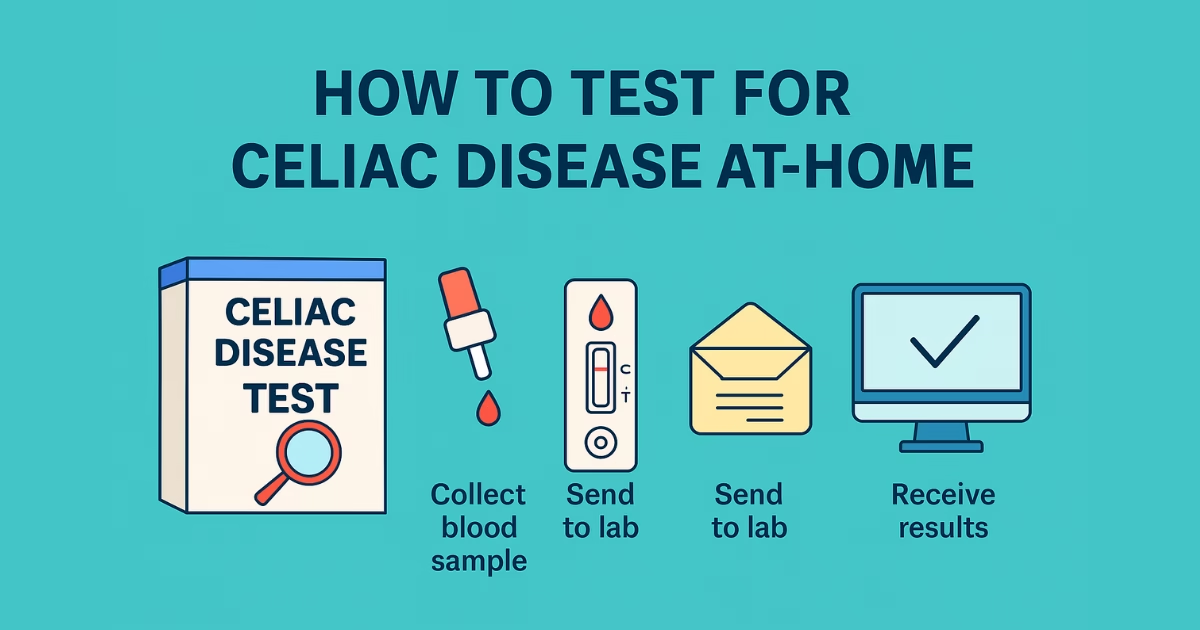Celiac disease is a serious autoimmune condition triggered by eating gluten, a protein found in wheat, barley, and rye. For those experiencing symptoms like digestive discomfort, fatigue, or unexplained anemia, testing is essential to get an accurate diagnosis. Many people wonder how to test for celiac disease at-home, seeking a convenient and private option before visiting a doctor. At-home testing kits have become popular because they offer an easy way to screen for celiac disease antibodies or related genes without an immediate clinic visit. While these tests provide useful preliminary information, it’s important to understand how they work, their limitations, and what to do after receiving results. This article will guide you through the process of at-home testing for celiac disease, helping you make informed decisions about your health.
How to Test for Celiac Disease At-Home: Step-by-Step Guide
Testing for celiac disease at home usually involves collecting a small blood or saliva sample and sending it to a lab for analysis. Most at-home kits focus on detecting specific antibodies in the blood, such as tissue transglutaminase (tTG) antibodies, which indicate an immune response to gluten. To start, you order a trusted test kit online or from a pharmacy. The kit will include detailed instructions on how to collect your sample, typically through a simple finger prick for blood or a saliva swab. After collecting the sample, you package it securely and send it back using the prepaid envelope provided. Results typically arrive within a few days or weeks through a secure online portal or by mail. It is important to continue eating gluten before testing to avoid false negatives. This process makes it possible to conveniently check for signs of celiac disease in the comfort of your home.
Types of At-Home Celiac Disease Tests Explained
There are mainly two types of at-home tests for celiac disease: serology tests and genetic tests. Serology tests check for antibodies that the body produces when gluten triggers an immune reaction. These antibodies include tTG-IgA, EMA, and DGP. The presence of these antibodies usually indicates celiac disease or gluten sensitivity. These tests require a small blood sample, usually collected through a finger prick.
Genetic tests, on the other hand, look for specific genes—HLA-DQ2 and HLA-DQ8—that are common in people with celiac disease. However, having these genes doesn’t mean someone has the disease; it only shows a predisposition. If a person doesn’t have these genes, celiac disease is highly unlikely.
Each test type has pros and cons. Serology tests are more useful for diagnosing active disease but need gluten in the diet to be accurate. Genetic tests are helpful in ruling out celiac disease but cannot confirm it alone.
Benefits and Limitations of At-Home Celiac Disease Testing
At-home testing offers clear benefits. It is convenient and private, allowing people to screen themselves without the pressure of a clinic visit. The process is simple and less intimidating for those worried about needles or medical environments. Early detection through home testing can encourage timely medical follow-up.
However, at-home tests also have limitations. False negatives can occur, especially if gluten has been avoided before testing. Home kits cannot replace a full medical diagnosis, which may require additional blood work or an intestinal biopsy. It’s also important to remember that symptoms alone are not enough to confirm celiac disease.
Therefore, at-home tests should be seen as a first step. Positive or unclear results must be followed by consultation with a healthcare provider for confirmation and proper management.
What to Do After At-Home Test Results
Once the at-home test results arrive, it’s important to interpret them carefully. A positive antibody test suggests an immune reaction to gluten and warrants a visit to a doctor for further evaluation. This may include professional blood tests and sometimes an intestinal biopsy to confirm the diagnosis.
If the results are negative but symptoms persist, it’s still advisable to consult a healthcare professional. Sometimes, tests can miss cases, or symptoms may be due to other conditions like non-celiac gluten sensitivity or irritable bowel syndrome.
Maintaining a gluten-containing diet until diagnosis is crucial. Going gluten-free before testing can cause antibody levels to drop, leading to false negatives.
After diagnosis, a strict gluten-free diet is necessary to manage the disease and prevent complications. Support from dietitians and medical experts helps in this transition.
Popular At-Home Celiac Test Kits and Where to Buy Them
Several reputable companies offer at-home celiac disease test kits. Some of the popular options include Celiac Check, EverlyWell, LetsGetChecked, and ImmunoLabs. These kits vary in price, sample type, and turnaround time for results.
Choosing the right kit depends on preferences like blood versus saliva sampling, the type of antibodies tested, and whether genetic testing is included. Buying from trusted sources, such as official websites or well-known pharmacies, ensures authenticity and reliable results.
It’s important to read reviews and product details carefully before purchasing. Some kits provide online support and access to healthcare professionals to discuss results.
FAQs About At-Home Celiac Disease Testing
Can I trust at-home tests?
At-home tests can be accurate for screening but are not definitive. They provide useful initial information but need medical follow-up.
How accurate are home tests compared to lab tests?
Home tests use the same lab techniques as clinics, so their accuracy is generally good. However, sample collection errors or diet changes can affect results.
What if I’m already on a gluten-free diet?
Testing after going gluten-free may give false negatives. It’s best to test while consuming gluten or discuss alternative diagnostic methods with a doctor.
Can children use at-home tests?
Some kits are suitable for children, but it’s important to consult a pediatrician before testing to ensure safety and accuracy.
Conclusion
Understanding how to test for celiac disease at-home can empower individuals to take charge of their health. At-home testing offers a convenient and private way to screen for celiac disease antibodies or genetic markers. While useful, these tests are only the first step toward diagnosis. Positive or uncertain results require medical confirmation to ensure accurate diagnosis and proper treatment.
Maintaining gluten in the diet before testing and consulting healthcare professionals afterward is essential. With the right approach, at-home testing can help identify celiac disease early and lead to better health outcomes.

Hi, I’m Shafy Ali – a curious mind and passionate writer at Celiac Magazine. I cover a little bit of everything, from everyday tips and how-tos to deeper dives into topics that spark conversation. I enjoy turning research into readable, relatable content that informs and inspires. Whatever the subject, I aim to keep it clear, engaging, and genuinely useful.

